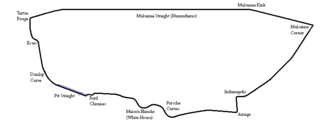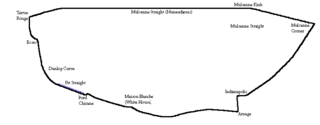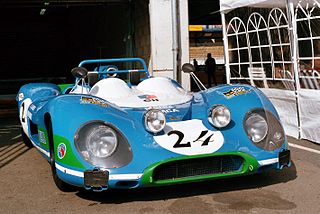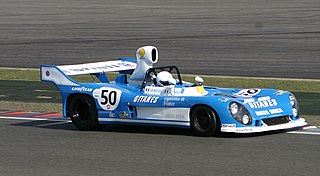Georges-Francis "Johnny" Servoz-Gavin was a French motor racing driver in both sportscars and single seaters.

The 1968 Canadian Grand Prix was a Formula One motor race held at the Circuit Mont-Tremblant in St. Jovite, Quebec, Canada on September 22, 1968. It was race 10 of 12 in both the 1968 World Championship of Drivers and the 1968 International Cup for Formula One Manufacturers. The 90-lap race was won by McLaren driver Denny Hulme after starting from sixth position. Hulme's teammate Bruce McLaren finished second and BRM driver Pedro Rodríguez came in third.

The 1968 Formula One season was the 22nd season of the FIA's Formula One motor racing. It featured the 19th World Championship of Drivers, the 11th International Cup for F1 Manufacturers, and three non-championship races open to Formula One cars. The World Championship was contested over twelve races between 1 January and 3 November 1968.

Jean-Pierre Maurice Georges Beltoise was a French Grand Prix motorcycle road racer and Formula One driver who raced for the Matra and BRM teams. He competed in 88 Grands Prix achieving a single victory, at the 1972 Monaco Grand Prix, and a total of eight podium finishes.

Henri Jacques William Pescarolo is a former racing driver from France. He competed in the 24 Hours of Le Mans a record 33 times, winning on four occasions, and won a number of other major sports car events including the 24 Hours of Daytona. He also participated in 64 Formula One World Championship Grands Prix, achieving one podium and 12 championship points. Pescarolo also drove in the Dakar Rally in the 1990s, before retiring from racing at the age of 57. In 2000 he set up his eponymous racing team, Pescarolo Sport, which competed in Le Mans until 2013. He wore a distinctive green helmet, and wears a full-face beard that partially covers burns suffered in a crash.

Michael Johnson Parkes was a British racing driver, from England. Parkes was born into an automotive background as his father John, was Chairman of the Alvis Group.

The 1973 24 Hours of Le Mans was the 41st Grand Prix of Endurance and took place on 9 and 10 June 1973. It was the eighth round of the 1973 World Championship of Makes.

The 1969 24 Hours of Le Mans was a motor race staged at the Circuit de la Sarthe, Le Mans, France on 14 and 15 June 1969. It was the 37th Grand Prix of Endurance and was the eighth round of the 1969 International Championship for Makes. The race was open to Group 6 Prototype Sports Cars, Group 4 Sports Cars and Group 3 Grand Touring Cars.
The 1968 24 Hours of Le Mans was the 36th Grand Prix of Endurance, and took place on 28 and 29 September 1968 on the Circuit de la Sarthe, in Le Mans, France.

The 1967 Spanish Grand Prix was a Formula One non-championship race held at Jarama on 12 November 1967.

The Matra-Simca MS650 is a Group 6 prototype race car introduced in 1969 for the International Championship for Makes. The MS650 replaced the previous Matra-Simca MS630.

The Matra MS5 is a Formula Two and Formula Three racing car, designed, developed, and made by Matra, which was used in the Formula Two class of two World Championship Grands Prix in 1966 and 1967. It was actively used in motor racing competitions between 1965 and 1969.

The Matra-Simca MS670 was a Group 5 prototype race car introduced in 1972 for the World Championship for Makes. The MS670 replaced the previous Matra-Simca MS660C.
The Matra MS620 was a Group 6 sports prototype built by Matra in 1966, and was the second such car built by the company. Fitted with a 1.9 litre version of the BRM Formula One V8 engine, four cars were built, but were mostly used as developmental cars. In 1967, the MS620 was replaced by the 3 litre Matra MS630, although it was used in the Le Mans Test of that year, fitted with a 4.7 litre Ford V8 engine.

The Matra Company's racing team, under the names of Matra Sports, Equipe Matra Elf and Equipe Matra Sports, was formed in 1965 and based at Champagne-sur-Seine (1965–1967), Romorantin-Lanthenay (1967–1969) and Vélizy-Villacoublay (1969–1979). In 1979 the team was taken over by Peugeot and renamed as Automobiles Talbot.

The Matra MS10 is a Formula One car entered by the Matra International team during the 1968 Formula One season. It, along with its V12-powered sibling MS11, was Matra's first purpose-built F1 car and won three races in 1968, taking Jackie Stewart to second place in the Drivers' Championship and Matra International to third place in the Constructors' Championship.

The Matra MS120 was the sixth and final Formula One car produced by Matra.

The Matra MS7 was a Formula Two racing car built by Matra, which occasionally raced in Formula One as well between 1967 and 1969.

The Matra-Simca MS660 is a Group 6 prototype race car introduced in 1969 for the International Championship for Makes. The MS660 replaced the previous Matra-Simca MS650.

The Matra MS640 is a sports prototype race car, designed, developed, and built by the French manufacturer Matra in 1969. Two examples of this car were made: the original one from 1969 and the rebuild from 2005.

















